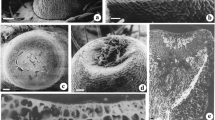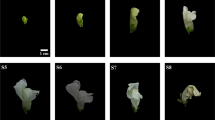Abstract
Previously, we found that secretory cell degradation typically occurred through programmed cell death during secretory cavity development in Citrus sinensis L. (Osbeck). This finding indicated that secretory cavities could be utilized as a new cell biology model for investigating the regulatory mechanisms of plant programmed cell death. To study further the programmed cell death during secretory cavity development in Citrus fruit, we studied the morphogenetic characteristics of secretory cavities during their development in Citrus grandis cv. Tomentosa. Using light microscope- and electron microscope-TUNEL assays, immunohistochemistry and immunocytochemistry, we described the precise spatial and temporal alterations in caspase 3-like distribution, chromatin condensation and DNA fragmentation during the programmed cell death of secretory cavity cells. Caspase 3-like was found to be significantly located in both the cytoplasm and the nucleus of secretory cavity cells undergoing programmed cell death, and caspase 3-like is closely associated with chromatin condensation and DNA fragmentation. Interestingly, both caspase 3-like and DNA fragmentation were detected in the nucleoli. Our findings suggest that caspase 3-like may be involved in the programmed cell death of secretory cavity cells, especially in chromatin condensation, DNA fragmentation, nuclear degradation and the degradation of certain organelles.











Similar content being viewed by others
References
Arends MJ, Morris RG, Wyllie AH (1990) Apoptosis. The role of the endonuclease. Am J Pathol 136:593–608
Baek D, Nam J, Koo YD, Kim DH, Lee J, Jeong JC, Kwak SS, Chung WS, Lim CO, Bahk JD, Hong JC, Lee SY, Kawai-Yamada M, Uchimiya H, Yun DJ (2004) Bax-induced cell death of Arabidopsis is meditated through reactive oxygen-dependent and -independent processes. Plant Mol Biol 56:15–27
Balk J, Leaver CJ (2001) The PET1-CMS mitochondrial mutation in sunflower is associated with premature programmed cell death and cytochrome c release. Plant Cell 13:1803–1818
Baran V, Fabian D, Rehak P, Koppel J (2003) Nucleolus in apoptosis-induced mouse preimplantation embryos. Zygote 11:271–283
Bennici A, Tani C (2004) Anatomical and ultrastructural study of the secretory cavity development of Citrus sinensis and Citrus limon: evaluation of schizolysigenous ontogeny. Flora 199:464–475
Bonneau L, Ge Y, Drury GE, Gallois P (2008) What happened to plant caspases? J Exp Bot 59:491–499
Bozhkov PV, Lam E (2011) Green death: revealing programmed cell death in plants. Cell Death Differ 18:1239–1240
Cacas J (2010) Devil inside: does plant programmed cell death involve the endomembrane system? Plant Cell Environ 33:1453–1473
Cao J, He XQ, Wang YQ, Cui KM (2003) Programmed cell death during secondary xylem differentiation in Eucommia ulmoides. Acta Bot Sin 45:1465–1474
Chen Y, Wu H (2010) Programmed cell death involved in the schizolysigenous formation of the secretory cavity in Citrus sinensis L. (Osbeck). Chinese Sci Bull 55:2160–2168
del Pozo O, Lam E (1998) Caspases and programmed cell death in the hypersensitive response of plants to pathogens. Curr Biol 8:1129–1132
Evans DE, Shvedunova M, Graumann K (2011) The nuclear envelope in the plant cell cycle: structure, function and regulation. Ann Bot Lond 107:1111–1113
Faleiro L, Kobayashi R, Fearnhead H, Lazebnik Y (1997) Multiple species of CPP32 and Mch2 are the major active caspases present in apoptotic cells. EMBO J 16:2271–2281
Fukuda H (2000) Programmed cell death of tracheary elements as a paradigm in plants. Plant Mol Biol 44:245–253
Gong QH, Wu Q, Huang XN, Sun AS, Shi JS (2005) Protective effects of Ginkgo biloba leaf extract on aluminum-induced brain dysfunction in rats. Life Sci 77:140–148
Granville DJ, Carthy CM, Jiang H, Shore GC, McManus BM, Hunt DWC (1998) Rapid cytochrome c release, activation of caspases 3, 6, 7 and 8 followed by Bap31 cleavage in HeLa cells treated with photodynamic therapy. FEBS Lett 437:5–10
Häcker G (2000) The morphology of apoptosis. Cell Tissue Res 301:5–17
Hao X, Qian J, Xu S, Song X, Zhu J (2008) Location of Caspase 3-like protease in the development of sieve element and tracheary element of stem in Cucurbita moschata. J Integr Plant Biol 50:1499–1507
Hara-Nishimura I, Hatsugai N, Nakaune S, Kuroyanagi M, Nishimura M (2005) Vacuolar processing enzyme: an executor of plant cell death. Curr Opin Plant Biol 8:404–408
Hatsugai N, Kuroyanagi M, Nishimura M, Hara-Nishimura I (2006) A cellular suicide strategy of plants: vacuole-mediated cell death. Apoptosis 11:905–911
Horky M, Wurzer G, Kotala V, Anton M, Vojtesek B, Vacha J, Wesierska-Gadek J (2001) Segregation of nucleolar components coincides with caspase-3 activation in cisplatin-treated HeLa cells. J Cell Sci 114:663–670
Janicke RU, Sprengart ML, Wati MR, Porter AG (1998) Caspase-3 is required for DNA fragmentation and morphological changes associated with apoptosis. J Biol Chem 273:9357–9360
Jones AM (2001) Programmed cell death in development and defense. Plant Physiol 125:94–97
Korthout HA, Berecki G, Bruin W, van Duijn B, Wang M (2000) The presence and subcellular localization of caspase 3-like proteinases in plant cells. FEBS Lett 475:139–144
Larsen BD, Rampalli S, Burns LE, Brunette S, Dilworth FJ, Megeney LA (2010) Caspase 3/caspase-activated DNase promote cell differentiation by inducing DNA strand breaks. Proc Natl Acad Sci USA 107:4230–4235
Li Y, Gong ZH, Sheng L, Gong YT, Tan XY, Li WM, Dong DL, Yang BF, Fu SB, Xue HJ (2009) Anti-apoptotic effects of a calpain inhibitor on cardiomyocytes in a canine rapid atrial fibrillation model. Cardiovasc Drugs Ther 23:361–368
Liang SJ, Wu H, Lun X, Lu DW (2006) Secretory cavity development and its relationship with the accumulation of essential oil in fruits of Citrus medica L. var. sarcodactylis (Noot.) Swingle. J Integr Plant Biol 48:573–583
Liang SJ, Wang H, Yang M, Wu H (2009) Sequential actions of pectinases and cellulases during secretory cavity formation in Citrus fruits. Trees Struct Funct 23:19–27
Lincoln JE, Richael C, Overduin B, Smith K, Bostock R, Gilchrist DG (2002) Expression of the antiapoptotic baculovirus p35 gene in tomato blocks programmed cell death and provides broad-spectrum resistance to disease. Proc Natl Acad Sci USA 99:15217–15221
Lu Z, Zhang C, Zhai Z (2005) Nucleoplasmin regulates chromatin condensation during apoptosis. Proc Natl Acad Sci USA 102:2778–2783
Meier I (2007) Composition of the plant nuclear envelope: theme and variations. J Exp Bot 58:27–34
Mills JC, Stone NL, Pittman RN (1999) Extranuclear apoptosis: the role of the cytoplasm in the execution phase. J Cell Biol 146:703–708
Papini A, Mosti S, Brighigna L (1999) Programmed-cell-death events during tapetum development of angiosperms. Protoplasma 207:213–221
Pennell RI, Lamb C (1997) Programmed cell death in plants. Plant Cell 9:1151–1157
Porter AG, Janicke RU (1999) Emerging roles of caspase-3 in apoptosis. Cell Death Differ 6:99–104
Rao L, Perez D, White E (1996) Lamin proteolysis facilitates nuclear events during apoptosis. J Cell Biol 135:1441–1445
Reape TJ, McCabe PF (2010) Apoptotic-like regulation of programmed cell death in plants. Apoptosis 15:249–256
Reipert S, Bennion G, Hickman JA, Allen TD (1999) Nucleolar segregation during apoptosis of haemopoietic stem cell line FDCP-Mix. Cell Death Differ 6:334–341
Rodrigues TM, dos Santos DC, Machado SR (2011) The role of the parenchyma sheath and PCD during the development of oil cavities in Pterodon pubescens (Leguminosae-Papilionoideae). C R Biol 334:535–543
Sahara S, Aoto M, Eguchi Y, Imamoto N, Yoneda Y, Tsujimoto Y (1999) Acinus is a caspase-3-activated protein required for apoptotic chromatin condensation. Nature 401:168–173
Sullivana T, Escalante-Alcaldea D, Bhattb H, Anverc M, Bhat N, Nagashimac K, Stewart CL, Burked B (1999) Loss of a-Type lamin expression compromises nuclear envelope integrity leading to muscular dystrophy. J Cell Biol 147:913–920
Sun YL, Zhao Y, Hong X, Zhai ZH (1999) Cytochrome c release and caspase activation during menadione-induced apoptosis in plants. FEBS Lett 462:317–321
Thornberry N, Lazebnik Y (1998) Caspases: enemies within. Science 281:1312–1316
van Doorn WG (2011) Classes of programmed cell death in plants, compared to those in animals. J Exp Bot 62:4749–4761
van Doorn W, Beers E, Dangl J, Franklin-Tong V, Gallois P, Hara-Nishimura I, Jones AM, Kawai-Yamada M, Lam E, Mundy J, Mur L, Petersen M, Smertenko A, Taliansky M, Breusegem F, Woltering T, Zhivotovsky B, Bozhkov PV (2011) Morphological classification of plant cell deaths. Cell Death Differ 18:1241–1246
Wang J, Xiao B, Zheng J, Chen H, Zou S (2007) Effect of targeted magnetic nanoparticles containing 5-FU on expression of bcl-2, bax and caspase 3 in nude mice with transplanted human liver cancer. World J Gastroenterol 13:3171–3175
Watanabe N, Lam E (2004) Recent advance in the study of caspase-like proteases and Bax inhibitor-1 in plants: their possible roles as regulator of programmed cell death. Mole Plant Pathol 5:65–70
Watanabe N, Lam E (2009) Programmed cell death in plants: apoptotic but not quite. Essentials of apoptosis. Humana Press, USA, pp 301–321
Widlak P, Garrard WT (2005) Discovery, regulation, and action of the major apoptotic nucleases DFF40/CAD and endonuclease G. J Cell Biochem 94:1078–1087
Woltering EJ (2010) Death proteases: alive and kicking. Trends Plant Sci 15:185–188
Yao N, Greenberg JT (2006) Arabidopsis ACCELERATED CELL DEATH2 modulates programmed cell death. Plant Cell 18:397–411
Yao N, Tada Y, Park P, Nakayashiki H, Tosa Y, Mayama S (2001) Novel evidence for apoptotic cell response and differential signals in chromatin condensation and DNA cleavage in victorin-treated oats. Plant J 28:13–26
Yao N, Eisfelder BJ, Marvin J, Greenberg JT (2004) The mitochondrion-an organelle commonly involved in programmed cell death in Arabidopsis thaliana. Plant J 40:596–610
Zhang L, Xu Q, Xing D, Gao C, Xiong H (2009) Real-time detection of caspase-3-like protease activation in vivo using fluorescence resonance energy transfer during plant programmed cell death induced by ultraviolet C overexposure. Plant Physiol 150:1773–1783
Acknowledgments
This work was supported by the National Natural Science Foundation of China (30670119, 31100240)to HW and NEDO 09E52018d to NY.
Conflict of interest
The authors declare that they have no conflict of interest.
Author information
Authors and Affiliations
Corresponding author
Additional information
Communicated by D. Treutter.
Rights and permissions
About this article
Cite this article
Liu, P., Liang, S., Yao, N. et al. Programmed cell death of secretory cavity cells in fruits of Citrus grandis cv. Tomentosa is associated with activation of caspase 3-like protease. Trees 26, 1821–1835 (2012). https://doi.org/10.1007/s00468-012-0752-1
Received:
Revised:
Accepted:
Published:
Issue Date:
DOI: https://doi.org/10.1007/s00468-012-0752-1




